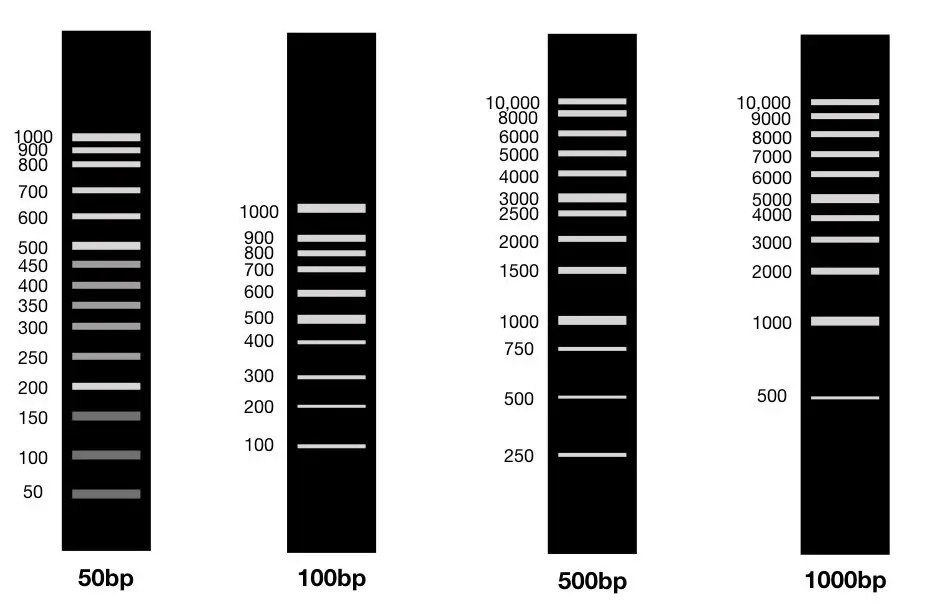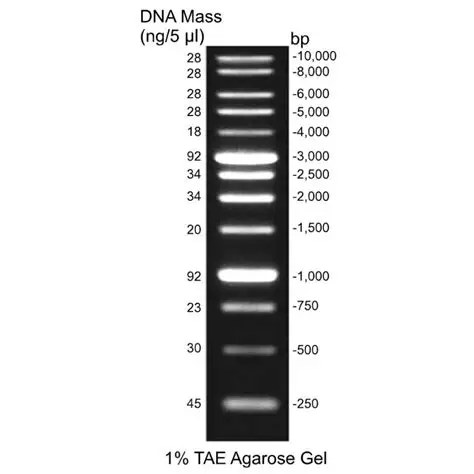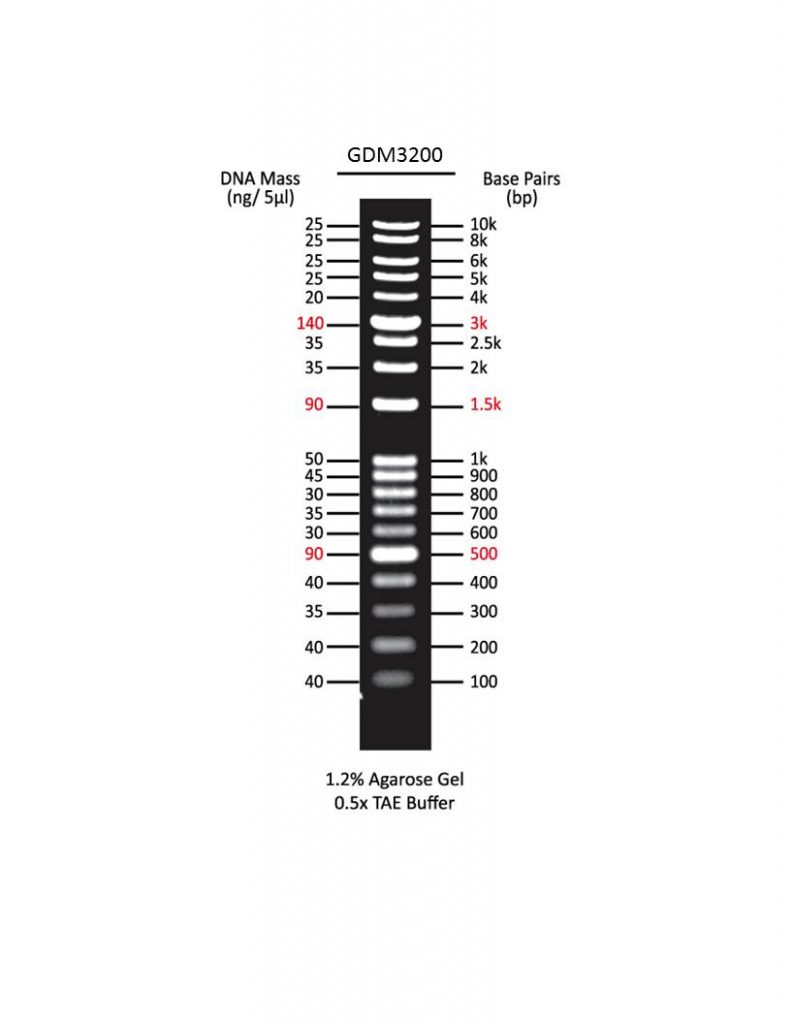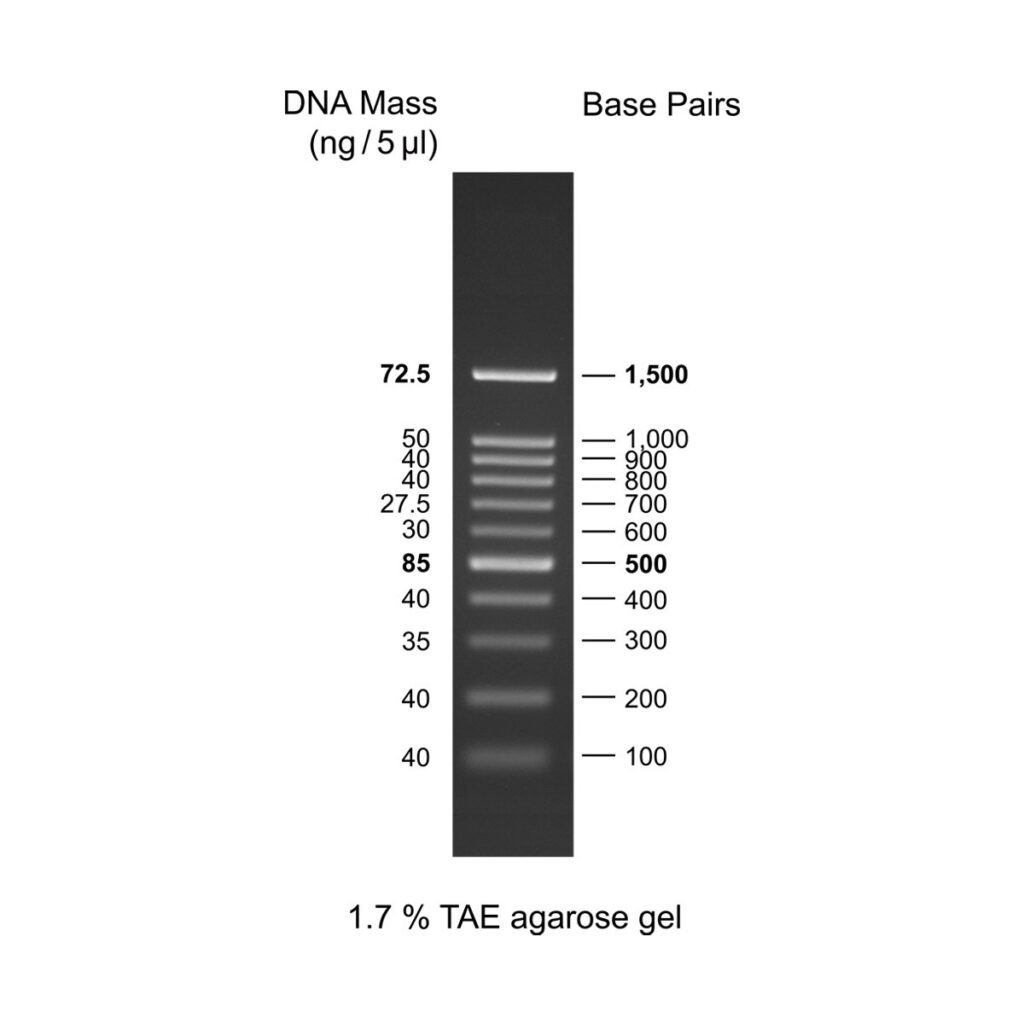Introduction
In the world of molecular biology, DNA ladder is an essential tool used in gel electrophoresis to estimate the size of DNA fragments. Whether you’re studying a gene, confirming PCR products, or cloning DNA, a DNA ladder acts like a molecular ruler that helps you interpret your results. It’s called a “ladder” because, when run on an agarose gel, it creates bands that look like the rungs of a ladder. Each band represents a DNA fragment of known size, usually measured in base pairs (bp) or kilobase pairs (kb).
Scientists use different types of DNA ladders depending on the expected size of the DNA fragments they are working with. The most commonly used ladders include:

- 1 kb DNA Ladder
- 1 kb Plus DNA Ladder
- 100 bp DNA Ladder
- 100 bp Plus DNA Ladder
Each has its own range and application. In this document, we will explore what these DNA ladders are, how they are made, how they are used in the laboratory, and how to choose the right one based on your experiment. The goal is to explain everything in a simple, humanized, and easy-to-understand way so that even beginners can grasp the concept.
Table of Contents
What is a DNA Ladder?
A DNA ladder is a mixture of DNA fragments of known lengths. These fragments are usually created by cutting a known DNA molecule with restriction enzymes or synthesizing them artificially. When these fragments are run through an agarose gel, they separate based on size, forming distinct bands.
These bands act as size markers. When you load your DNA sample next to the ladder, you can compare the distance traveled by your DNA fragments with the ladder’s bands to estimate their size.
Why is a DNA Ladder Important?
DNA molecules are invisible to the naked eye, and they do not come labeled with size information. That’s why a DNA ladder is crucial in every gel electrophoresis experiment. It helps you:
- Determine the size of unknown DNA fragments
- Verify the success of PCR amplification
- Confirm the presence of target DNA
- Compare DNA fragment patterns in different samples
Without a DNA ladder, it would be nearly impossible to know the length of DNA bands in a gel.
Principle of DNA Ladders in Gel Electrophoresis
Gel electrophoresis is a technique that separates DNA fragments based on size. DNA molecules are negatively charged, so when they are placed in an electric field, they move toward the positive electrode. Smaller fragments move faster and farther through the gel matrix, while larger fragments move more slowly.
A DNA ladder provides a set of reference points. The known sizes of the ladder bands help you estimate the size of DNA fragments in your sample by comparing how far they have migrated through the gel.
Types of DNA Ladders
Let’s explore the most commonly used DNA ladders in detail:
1. 1 kb DNA Ladder
Definition:
A 1 kb DNA ladder consists of DNA fragments that are spaced in 1,000 base pair (1 kb) increments. It typically ranges from 500 bp to 10,000 bp.

Common Band Sizes:
500 bp, 1 kb, 2 kb, 3 kb, 4 kb, 5 kb, up to 10 kb
Key Features:
- Designed for sizing large DNA fragments
- Visible bands for each kb mark
- Ideal for general cloning and genomic DNA analysis
Uses:
- Estimating the size of plasmids or large PCR products
- Checking restriction enzyme digestion products
- Analyzing genomic DNA
- Confirming ligation products in cloning experiments
2. 1 kb Plus DNA Ladder
Definition:
A 1 kb plus DNA ladder is similar to the 1 kb ladder but includes extra bands for more precise estimation, especially for larger fragments.

Common Band Sizes:
Ranges from 500 bp up to 12,000 bp with additional bands at irregular intervals (e.g., 1.5 kb, 3.5 kb, 6 kb)
Key Features:
- Extended range compared to standard 1 kb ladder
- Useful for large constructs or complex digests
- More reference points for better accuracy
Uses:
- Mapping large restriction fragments
- Verifying large constructs like BACs or genomic inserts
- High-throughput cloning where size precision is important
3. 100 bp DNA Ladder
Definition:
A 100 bp DNA ladder consists of fragments that increase in 100 base pair increments. It usually ranges from 100 bp to 1,000 bp.

Common Band Sizes:
100 bp, 200 bp, 300 bp, … up to 1,000 bp
Key Features:
- Designed for small DNA fragments
- Easy to distinguish individual bands
- Ideal for small amplicons
Uses:
- Verifying small PCR products
- Analyzing short restriction fragments
- DNA fingerprinting and STR analysis
- Real-time PCR verification
4. 100 bp Plus DNA Ladder
Definition:
This ladder includes the standard 100 bp increments plus additional bands at specific intervals for better accuracy.
Common Band Sizes:
100 bp, 150 bp, 200 bp, 300 bp, 400 bp, 500 bp, 750 bp, 1,000 bp, 1,500 bp
Key Features:
- Enhanced accuracy with plus bands
- Helps in resolving closely sized fragments
- Preferred for high-resolution applications
Uses:
- High-resolution gel electrophoresis
- Differentiating similar-sized PCR products
- STR or VNTR analysis in forensic labs
- Quality control in DNA quantification assays
Comparison Table of Common DNA Ladders
| DNA Ladder Type | Size Range | Increments | Best For | Limitations |
|---|---|---|---|---|
| 1 kb Ladder | 500 bp – 10 kb | 1,000 bp | Genomic DNA, plasmids | Not ideal for small fragments |
| 1 kb Plus Ladder | 500 bp – 12 kb | Irregular + 1 kb | Large constructs, complex digests | Can be cluttered |
| 100 bp Ladder | 100 bp – 1,000 bp | 100 bp | Small PCR fragments | Not suitable for large DNA |
| 100 bp Plus Ladder | 100 bp – 1,500 bp | 100 bp + extra | High-resolution sizing | More expensive |
Choosing the Right DNA Ladder
The right DNA ladder depends on the size of DNA you expect to see in your gel. Here’s how to choose:
- Use 100 bp or 100 bp Plus Ladder if you are analyzing small PCR amplicons, microsatellites, or small restriction fragments (less than 1,000 bp).
- Use 1 kb Ladder for regular cloning applications and for sizing fragments between 500 bp and 10 kb.
- Use 1 kb Plus Ladder when working with very large fragments or complex DNA such as BACs, YACs, or genomic libraries.
How to Use a DNA Ladder
Step 1: Prepare the Gel
- Choose an appropriate percentage of agarose gel based on the DNA fragment sizes.
- For small fragments (100–1,000 bp), use 2–3% agarose.
- For large fragments (1 kb–12 kb), use 0.7–1% agarose.
Step 2: Load the Ladder
- Mix the DNA ladder with a loading dye.
- Load 3–5 µL of the ladder into the first well of the gel.
- Load your DNA samples into the adjacent wells.
Step 3: Run the Gel
- Apply voltage (typically 80–120 V).
- Run until the dye front reaches near the end of the gel.
Step 4: Visualize the Gel
- Stain the gel using ethidium bromide, SYBR Safe, or GelRed.
- Use a UV transilluminator or blue-light imager.
- Compare the bands of your sample to the ladder to estimate sizes.
Factors Affecting DNA Ladder Performance
- Gel concentration: Higher concentration resolves small fragments better.
- Voltage: Too high voltage can distort band shape.
- Staining: Poor staining affects visibility of bands.
- Buffer: Always use fresh TAE or TBE buffer for consistent migration.
- Loading volume: Under-loading or overloading affects band sharpness.
Storage and Handling of DNA Ladders
- Store ladders at -20°C for long-term use.
- Keep small aliquots to avoid repeated freeze-thaw cycles.
- Always use clean pipette tips to avoid contamination.
- Avoid exposing to UV light for prolonged periods during visualization.
Commercially Available DNA Ladders
Many biotechnology companies sell pre-made DNA ladders:
- Thermo Fisher Scientific
- New England Biolabs (NEB)
- Promega
- Bio-Rad
- Sigma-Aldrich
They often come with:
- Pre-stained bands
- Ready-to-load format with loading dye
- Fluorescent markers for real-time detection
Applications of DNA Ladders
1. PCR Verification
DNA ladders help confirm that a PCR reaction has amplified the correct product by comparing the band size to expected length.
2. Restriction Enzyme Analysis
When DNA is digested with restriction enzymes, a DNA ladder helps estimate the size of resulting fragments.
3. Molecular Cloning
DNA ladders are used to analyze ligation and digestion steps in cloning workflows.
4. Genotyping and DNA Profiling
Used in forensic science and paternity testing to analyze STRs or other polymorphic markers.
5. RNA Analysis (with cDNA)
While RNA ladders are used specifically for RNA, DNA ladders are often used to check cDNA synthesis before qPCR.
6. Quality Control in Laboratories
Ladders act as internal standards for checking the quality of DNA preparations and confirming integrity.
7. Educational and Training Labs
Used in teaching students about molecular biology techniques like electrophoresis, gel loading, and DNA size estimation.
Limitations of DNA Ladders
- Not always linear: Migration may not be linear across all fragment sizes.
- Smearing or missing bands: Improper storage or use can affect accuracy.
- Resolution limits: Some ladders may not resolve closely sized fragments well.
- Species-specific biases: Ladders are universal, but genome composition may affect fragment mobility in some cases.
Innovations in DNA Ladders
- Pre-stained ladders: Contain dyes that fluoresce without staining the gel separately.
- Dual-color ladders: Different dye colors for easier orientation.
- Custom ladders: Designed for specific applications like NGS or barcoding.
- Digital ladders: Ladder images overlaid digitally in real-time gel imaging systems.
Conclusion
DNA ladders are the unsung heroes of molecular biology. They silently guide researchers in understanding their DNA results, validating experiments, and making accurate conclusions. Whether you’re a student learning gel electrophoresis or a scientist working on gene therapy, DNA ladders provide the essential reference you need.
Choosing the right ladder, handling it properly, and interpreting it correctly are all crucial steps in successful DNA analysis. With various types available—1 kb, 1 kb Plus, 100 bp, and 100 bp Plus—you can always find one that fits your experiment perfectly. As techniques become faster and more precise, so do the DNA ladders that support them.
Three Key Takeaways
- DNA ladders contain fragments of known sizes used to estimate the size of unknown DNA in gel electrophoresis.
- The choice of ladder—1 kb, 1 kb Plus, 100 bp, or 100 bp Plus—depends on the expected size of your DNA fragments.
- DNA ladders are essential in PCR verification, restriction analysis, cloning, and genetic studies across labs worldwide.
FREQUENTLY ASKED QUESTIONS
What is the difference between 100 bp and 100 bp Plus ladders?
The 100 bp ladder contains evenly spaced 100 bp bands. The 100 bp Plus ladder includes additional bands (like 150 bp or 750 bp) for higher resolution and better accuracy.
Can I use a 1 kb ladder for small DNA fragments?
You can, but it’s not ideal. Small fragments (under 500 bp) may not be resolved clearly in a 1 kb ladder. A 100 bp ladder is more suitable for small fragments.
How long can I store a DNA ladder?
If stored at -20°C and handled properly (without repeated freeze-thaw), DNA ladders can last for several months to a year. Always check the manufacturer’s guidelines.
Related Articles




